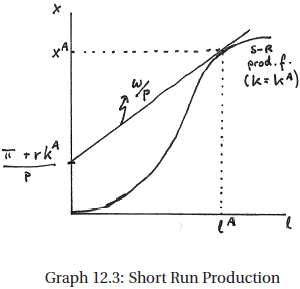We have said that economic profit is equal to economic revenue minus economic costwhere cash inflows or
Question:
A: In the short run, however, it can only change the level of labor input because it has already committed to a particular capital input level for the coming months. Assume that the firm's homothetic production process is one that has initially increasing but eventually decreasing returns to scale €” and that the marginal product of each input is initially increasing but eventually decreasing. (The full production frontier would then look something like what we have plotted in Graph 12.2.)
(a) Suppose the firm is currently implementing the profit maximizing production plan denoted A = („“A,kA,xA). Given input prices w and r and output price p, what is the expression for the profit this firm earns.

(b) Now consider the short run where capital is fixed at kA. Graph the short run production function for this firm.
(c) Add to this graph the slice of the isoprofit plane that is tangent to the production frontier at A. Indicate its slope and vertical intercept.
(d) Given that we learned in Chapter 11 that the vertical intercept of the isoprofit is equal to profit (along that isoprofit) divided by output price, what does the vertical intercept in your graph suggest is the profit for this firm when viewed from the short run perspective.

(e) Explain why the short run perspective of economic profit differs in this case fromthe long run perspective.
(f) True or False: It is possible for a firm to be earning zero profit in the long run but positive profit when viewed from a short-run perspective.
B: Suppose that, instead of the production process described in part A, the production frontier is characterized by the Cobb-Douglas production function x = f („“,k) = A„“αkβ with α+β < 1 and A,α,and β all greater than zero.
(a) Does this production process have increasing, decreasing or constant returns to scale?
(b) Set up the profit maximization problem.
(c) Solve this for the optimal production plan.
(d) Now consider the short run profit maximization problem for the firm that is currently employing  of capital. Write down the firm's short run production function and its short run profit maximization problem.
of capital. Write down the firm's short run production function and its short run profit maximization problem.
(e) Solve for the short run labor demand and output supply functions.
(f) Suppose that the short run fixed capital is equal to the long run optimal quantity you calculated in part (c). Demonstrate that the firm would then choose the same amount of labor in the short run as it does in the long run.
(g) Finally, illustrate that profit is larger from the short run perspective than the long run perspective.
Step by Step Answer:

Microeconomics An Intuitive Approach with Calculus
ISBN: 978-0538453257
1st edition
Authors: Thomas Nechyba





